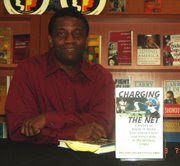
As a veteran observer of all things Yankee, I don’t believe reports that the team’s divorce from Johnny Damon is final.
General manager Brian Cashman says the Yankees won’t resign the 36-year-old outfielder because the club needs to get younger and more athletic and keep the 2010 payroll under $200 million.
I’m not buying it.
When has payroll mattered to the New York Yankees?
The Yanks have never cared about paying a luxury tax (not even this season’s $25 million tax) for exceeding baseball’s salary threshold as long as they’re getting maximum bang for their bucks.
And a 27th World Series championship certainly qualifies as money well-spent.
During the Steinbrenner Era, the Yankees have always tried to field the best team money can buy.
The Yankees can achieve that again in 2010 if Damon takes the initiative and follows a strategy already executed by Alex Rodriguez.
No, that doesn’t mean Damon should divorce his wife and date free-agent starlet Kate Hudson.
Instead, Damon should tell agent Scott Boras exactly what A-Rod told him after negotiations with the Yankees had been severed following the ’07 season:
Butt out.
If Damon himself tells Cashman and the Steinbrenner boys, Hank and Hal, that he wants to stay, then they’ll make a deal.
Boras, in typically nauseating fashion, alienated the Yankees by saying publicly the club should give Damon the kind of multi-year deal it gave catcher Jorge Posada at age 36 and relief ace Mariano Rivera at age 39 and will give shortstop Derek Jeter who turns 36 in June.
That is not going to happen. Nor should it happen.
Jeter, Rivera and Posada have become Yankee icons. Along with southpaw Andy Pettitte, they’re the only on-field links to the dynastic Yankee teams of the late 1990s-early 2000s.
Those players have earned special treatment.
The Yankees essentially told
The Yankees then traded for former Tigers All-Star Curtis Granderson—at 29, a superior athlete and outfielder to Damon—and signed free agent Nick Johnson, an ex-Yankee whose on-base percentage is one of baseball’s best.
Damon should remind
The Yankees would offer Damon a two-year, $16-million deal if he wants it. I’ve followed this club long enough to know that.
A-Rod is a Yankee today—with a world championship on his resume, finally—because he personally told the club he wanted to stay and he muzzled
There may be more upfront money elsewhere for Damon, or even a three-year deal, but he wouldn’t be a Yankee. He wouldn’t be playing for the reigning world champions, the most celebrated franchise in professional sports, in the media capital of the world.
It can’t make more sense to Damon to finish his career with the White Sox, Orioles or Royals.
Would the Red Sox offer him a return to Beantown?
Maybe. But only to try to tweak the Yankees, the team that tweaked them when Damon signed his four-year, $52 million deal after the ’05 season.
But that move wouldn’t make sense for the Sox, who need to get younger and more athletic just like the Yankee team they’re now chasing.
Damon should want to be part of the 2010 Yankees, part of what would be one of baseball’s most potent lineups ever:
SS Derek Jeter
LF Johnny Damon
1B Mark Teixeira
3B Alex Rodriguez
C Jorge Posada
CF Curtis Granderson
2B Robinson Cano
RF Nick Swisher
DH Nick Johnson
You could quibble with the batting order. You could even bat Granderson ninth (if he’s not insulted), but this lineup coupled with the Yankees’ pitching staff would be favored to win another world championship.
Damon should want a piece of that action.
But first he needs to follow A-Rod’s lead and check his agent at the door.








